Connection Updates: What's Changed and Why
July 2025 : Making Connection Fields More Intuitive
What's Really Changing?
Clearer Language
We're flipping how we describe relationships to better match how you think
Better setup experience
No more confusion about which table to use
Nothing breaks
All existing connections work exactly as they have been
Think of it like this:
Instead of saying 'one company has many contacts,' we now say 'many contacts belong to one company.' It's the same relationship, just described from the perspective that makes more sense to most users.
Existing connections in both Classic and Next-Gen connection fields continue to function as expected with some interface updates.
New Connection Behavior in Next-Gen
When creating new connection fields in Next-Gen apps, you'll see these available connection types:
Many → One
Multiple records in the current table can connect to one record in the connected table
Many → Many
Multiple records in the current table can connect to multiple records in the connected table
One → One
Each record in the current table can connect to one record in the connected table

The One --> Many option is not available in the connection type selector for new connection fields.
Existing Connection Examples, Previous to this Change
One --> Many (In Classic and Next-Gen)
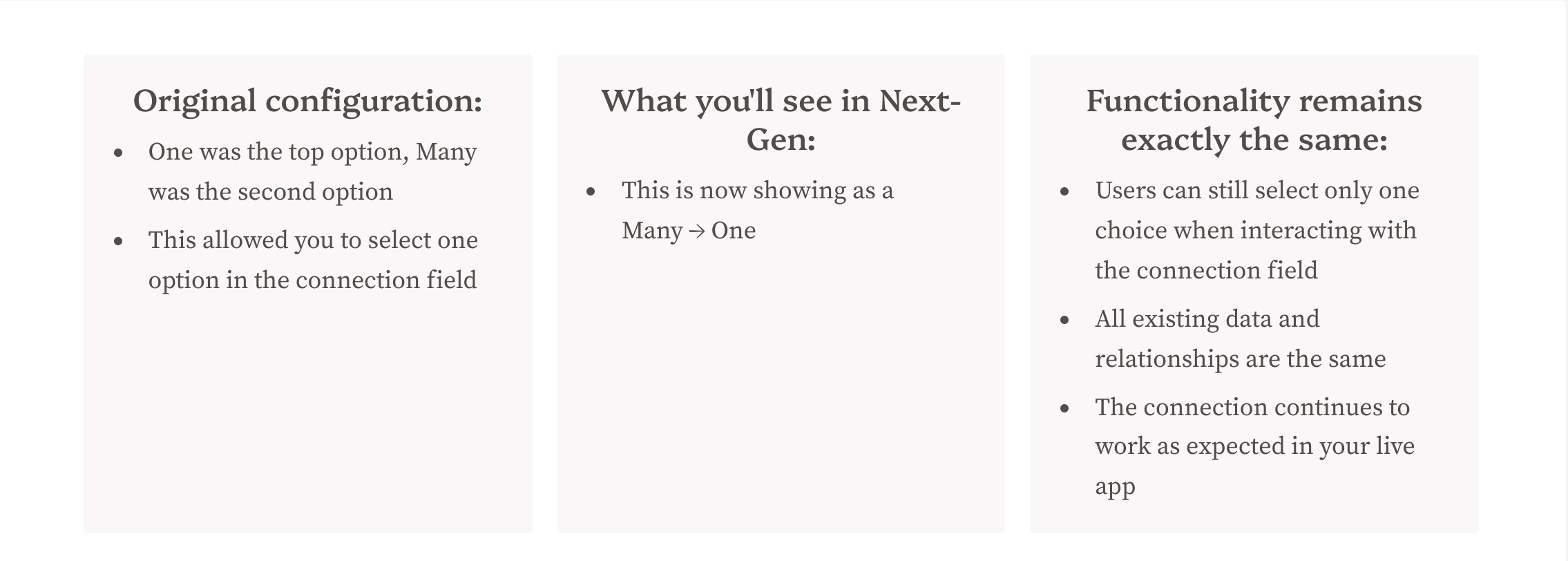
Example of the One --> Many in Classic:
In this example (from Classic Knack), while on the Leads table, a connection field is created to the Contacts table, and the default selections of One and Many were kept.
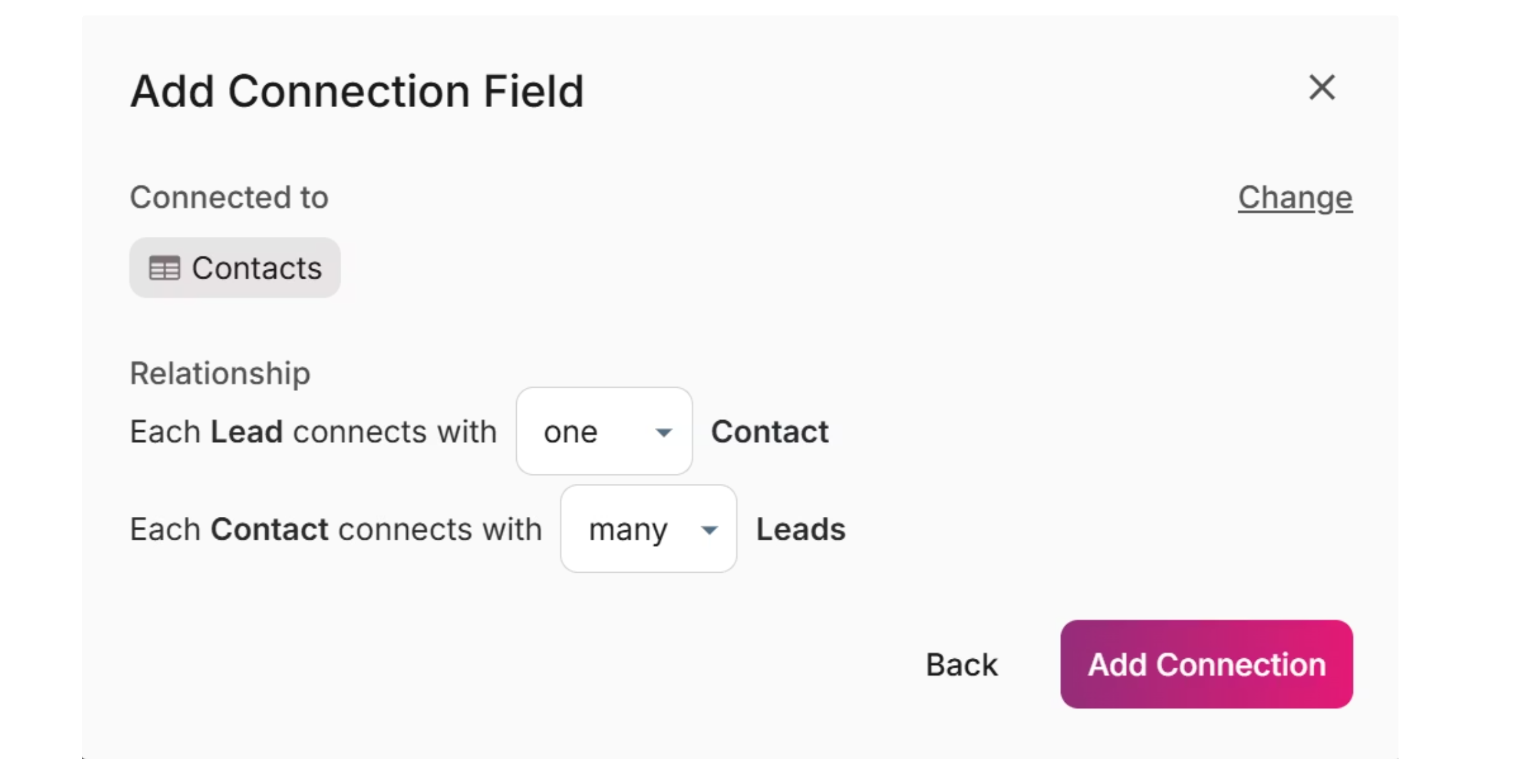
What you'll see in Next-Gen:
This is now showing as Many --> One
Functionality remains exactly the same
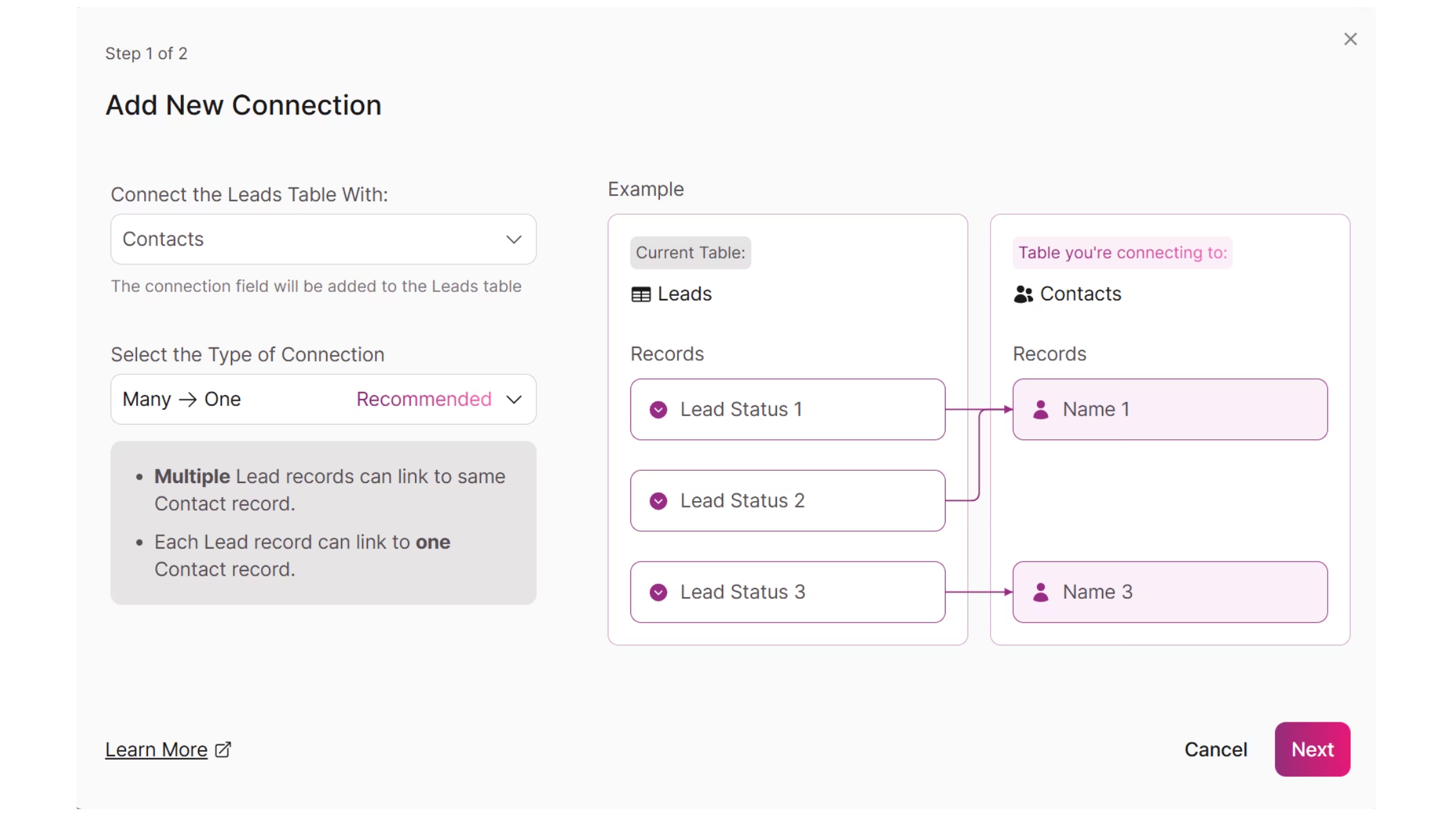
Interface changes in Edit Connection Field:
- The connection field will display as "Many → One" in the field editor
- The selection called "One → Many" option appears as disabled with a "Deprecated" label in the connection type dropdown
- You cannot select the deprecated One → Many option
- If your use case changes, you can still change the connection type to Many → Many or One → One connection type
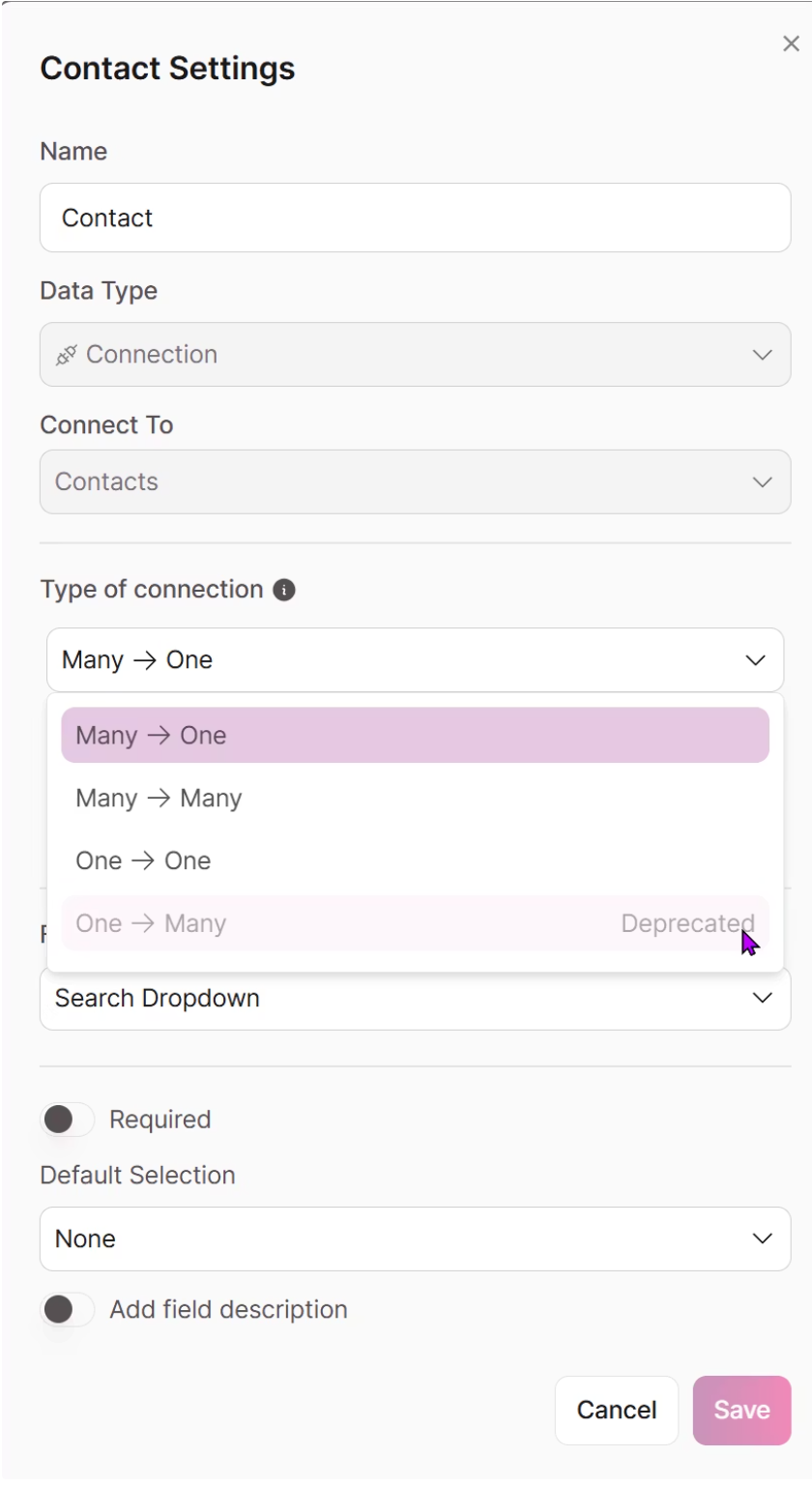
Why We Made This Change
The changes were made to align the interface language with how users naturally think about and set up table relationships, and how we teach users to set up connections on the "many" table.
The Problem: Confusing Language: Users kept asking: "Do I create this on the Company table or Contact table?"
The Solution: Natural Language: Now it's obvious: Many contacts belong to one company" → Create the field on the Contacts table
Real-world analogy: You naturally think "this contact works at that company," not "that company owns this contact."

By simplifying the options for new connections and encouraging users to create "Many → One" connections from the appropriate table with a dynamic visual, errors in setting up connections will be reduced, and creating relationships will be more straightforward. Users will be less likely to create connections on the wrong table or get confused about which connection type to choose.
Many --> One Connections (In Classic and Next-Gen)
In this example, a connection is created while on the Invoice Line Items table to the Invoices table, but the default One and Many settings were manually reversed to Many and One.
As a result, a single Invoice Line Item can connect to multiple Invoices, which is an outcome that typically doesn't reflect the intended workflow.

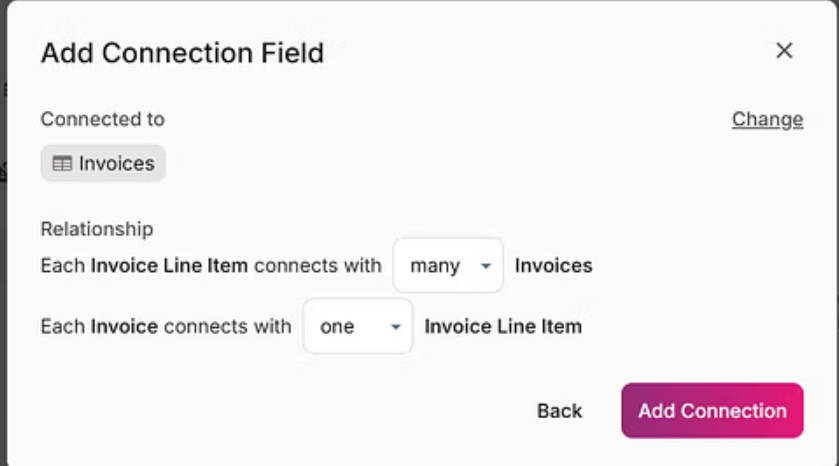
To help prevent incorrect scenarios like the above, where an Invoice Line Item might connect to multiple Invoices, the default Many → One selection and dynamic visuals help guide users to place connection fields correctly and more intuitively from the start.
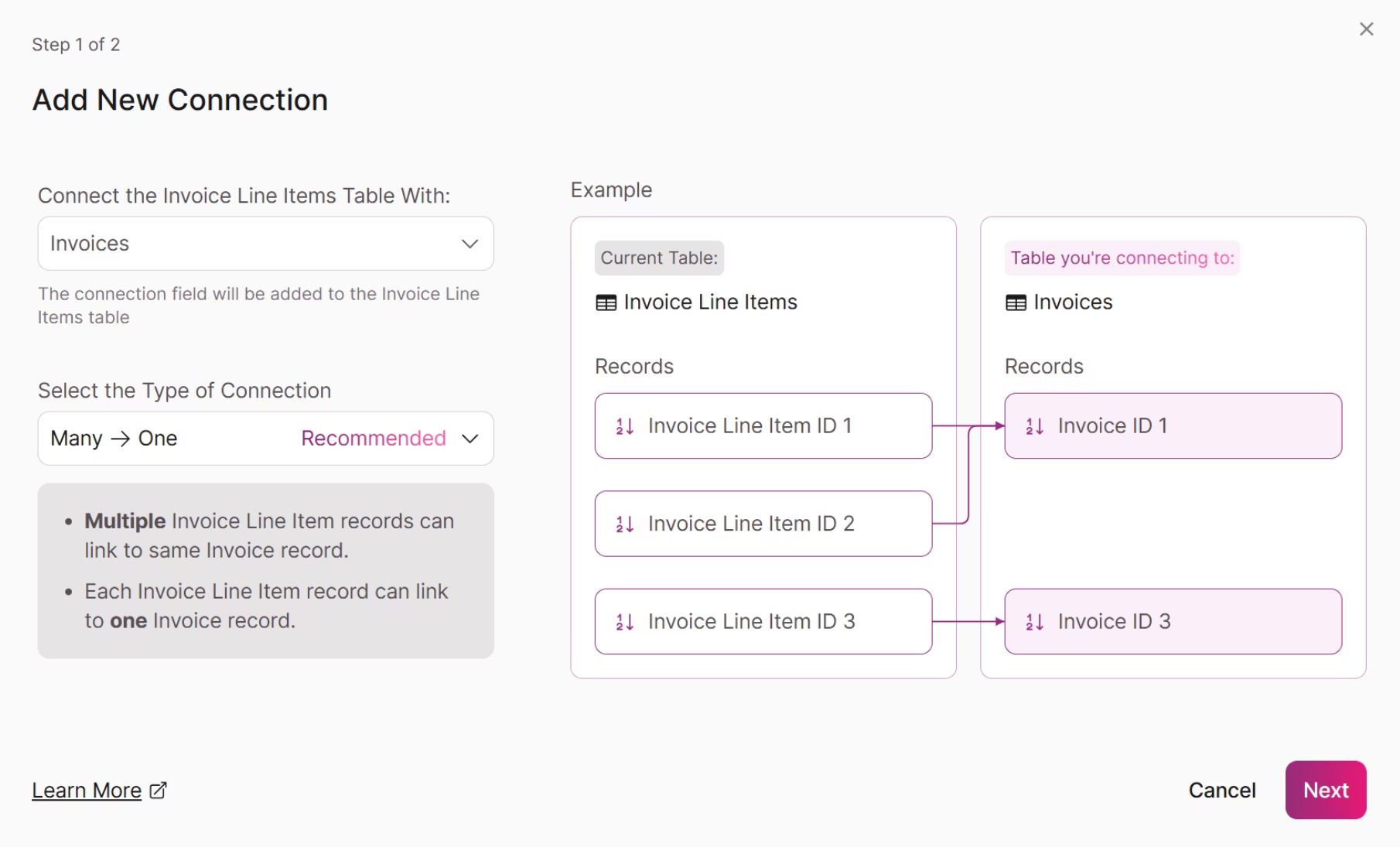
Working with Connections that have a deprecated status

Do you need to change a deprecated connection type?
No, not if the current functionality works perfectly for your use case
Normal Functionality
Connection types marked as "Deprecated" in Next-Gen continue to function normally in your live app and builder, in both Classic and Next-Gen.
Not available for with new Connections
Cannot be selected as an option when creating new connections in Next-Gen.
No Re-selection
Cannot be re-selected if you change the connection type in Next-Gen
Modifying Connections
Modifying the connection type is generally rare.
More commonly, the connection field was set up on the incorrect table, or with the incorrect selections. Like in the previous example, while in the Invoice Line Items table, a connection field was added to the Invoice table, but the selections were changed to Many Invoices to One Invoice Line Item.
It may be best not to change the connection type, but, while on the Invoice Line Items table, create a new connection field to the Invoices table with the default Many —> One selection. Delete the incorrect connection field from the Invoices table afterwards.
⚠️Note that any elements, views, rules, equation & formula fields will also cease to work or be deleted if the incorrect connection field is deleted.
Before Changing Connection Types
If you're planning to change an existing connection type:
- Document your current connections - Note which tables use which connections
- Review data relationships - Understand how your connections are being used. The Data Model helps to visualize connections between tables.
- Test changes safely - Duplicate your app and test modifications first, in the Builder and the Live App
Data Preservation During Connection Type Changes
In both Classic and Next-Gen, if your use case changes, and you change connection types for existing fields:
- No data loss occurs - All previously selected connection values are preserved
- Behavior changes going forward - New record selections will follow the rules of the new connection type
- For example: If you change an existing Many → Many connection type to a Many → One connection type, users will only be able to select one option in new records, but existing multiple selections remain intact
Connections Best Practices and Examples
💡 Simple Rule: Ask 'What Contains What?'
- The container is the "one"
- The contents are the "many"
Create the connection field while on the "many" table
Invoices contain Line Items → Create the connection field to Invoices while on the Line Items table
Companies contain Contacts → Create the connection field to Company while on the Contacts table
Many → One Examples
Project Management
Tables: Tasks and Projects
- Each Task belongs to one Project, and one Project can have many Tasks
- While on the Tasks table, create a connection field to the Projects table
Education
Tables: Students and Schools
- Each Student attends one School, and one School can have many Students
- While on the Students table, create a connection field to the Schools table
E-commerce Example
Tables: Products and Categories
- Each Product belongs to one Category, and one Category can contain many Products
- While on the Products table, create a connection field to the Categories table
Many → Many Examples
Determine the "many" table. This is generally the table Live App users will be working with the most. After the connection is created, then while on the "many" table, you'll be able to select multiple options in the connection field dropdown.
Event Management
Tables: Events and Speakers
- Each Event can have multiple Speakers, and each Speaker can present at multiple Events
- Create the connection field on either table depending on your workflow (commonly on the Events table for event planning workflows, where new records are created more often)
Course Registration
Tables: Students and Courses
- Each Student can enroll in multiple Courses, and each Course can have multiple Students
- Create the connection field on either table depending on your primary workflow (commonly created while on the Courses table, to easily add and remove students from Courses)
Content Management
Tables: Articles and Tags
- Each Article can have multiple Tags, and each Tag can be applied to multiple Articles
- Create the connection field on either table depending on your workflow (commonly created while on the Articles table for content organization)
One → One Examples
User Profiles
Tables: Users and User Profiles
- Each User has exactly one User Profile, and each User Profile belongs to exactly one User
- Create the connection field on either table (often on User Profiles for detailed information management)
Order Processing
Tables: Orders and Shipping Information
- Each Order has exactly one Shipping Information record, and each Shipping Information belongs to exactly one Order
- Commonly created on the Shipping Information table
Employee Management
Tables: Employees and Employee Details
- Each Employee has exactly one Employee Details record for sensitive information
- Create the connection field while on the Employee Details table to limit sensitive data access
Updated 2 months ago
